|
|
|
|
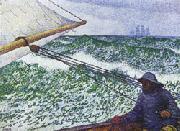 |
Theo Van Rysselberghe
|
|
Belgian Pointillist Painter, 1862-1926
was a Belgian neo-impressionist painter, who played a pivotal role in the European art scene at the turn of the century. Born in Ghent to a French-speaking bourgeois family, he studied first at the Academy of Ghent under Theo Canneel and from 1879 at the Academy of Brussels under the directorship of Jean-François Portaels. The North African paintings of Portaels had started an orientalist fashion in Belgium. Their impact would strongly influence the young Theo van Rysselberghe. Between 1882 and 1888 he made three trips to Morocco, staying there a total of one year and half. Barely 18 years old, he already participated at the Salon of Ghent, showing two portraits. Soon afterwards followed his Self-portrait with pipe (1880), painted in somber colours in the Belgian realistic tradition of that time. His Child in an open spot of the forest (1880) already departs from this style and he sets his first steps towards impressionism. |
|
|
|
 |
Theodoor Rombouts
|
|
Flemish , b. 1597, Antwerpen, d. 1637, Antwerpen
was a Flemish Baroque painter specializing in Caravaggesque genre scenes of card players and musicians. He studied under Abraham Janssens in Antwerp and was in Italy between 1616 and 1625, where he was heavily influenced by Caravaggio. |
|
 |
Theodor Rocholl
|
|
(1854-1933), German military painter and war artist.
Rocholl was born in Sachsenberg (Waldeck) on June 11, 1854, the son of Rudolf Rocholl, the Lutheran theologian and philosopher. He was a student in Munich in 1877, then at the Dresden Academy. After a year, he moved to Munich where he studied historical painting under Karl von Piloty. He ocmpleted his art studies at the Desseldorf Academy where he developed his interest in military art under the influence of Wilhelm Camphausen; his contemporaries in this field were Carl Röchling and Richard Knötel. The artist observed the Franco-Prussian War and the subsequent German army manoeuvres between 1883 and 1888; in 1890, he traveled to Russia to view the German Garde-Korps on manoeuvre. Later in the decade, he was attached to the Turkish Army and covered the conflict in Thessalia in 1897 between the Turks and the Greeks; his sketches of the fighting were published the following year. He covered the Boxer Rebellion in 1900 as the official artist of the German expeditionary force. A decade later, he covered the fighting between Turkey and Albania.
Many of his paintings depict German military scenes, especially the battles of the Franco-Prussian War. One of his most famous pictures depicted King William at the Battle of Sedan, meeting his triumphant soldiers after the victory. Rocholl also painted a large mural for the Evangelischen Padagogiums in Bad Godesberg.
In his 60th year, he became a war artist covering the campaign on the Western Front. His War Letters printed in 1916 in which he described the fear and destruction. An autobiography of his life as a painter appeared in 1921. He died in a streetcar accident Desseldorf in his 80th year on September 14, 1933.
|
|
 |
Theodore R. Davis
|
|
1840 ?C 1894,was a 19th century American artist, who made numerous drawings of significant military and political events during the American Civil War and its aftermath. Some of these drawings include the Battle of Champion Hill, and the most significant sketch of General Joseph E. Johnston and General William T. Sherman meeting at the Bennett Farm near Durham Station to discuss the surrender terms of the remaining Confederate armies in the Southeast. After the war when the Cyclorama in Atlanta was being painted, Davis was asked for his ideas having traveled with Sherman's army. He was later added to the painting. |
|
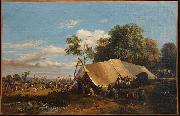 |
Theodore Ravanat
|
|
(born in Grenoble on 4 May 1812, died in Proveysieux on 21 September 1883) was a French landscape painter. Ravanat's work is mostly composed of Dauphine landscapes. His paintings are generally among private collections of Grenoble, but some of these paintings can be seen at the Museum of Grenoble or the Musee dauphinois. |
|
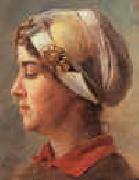 |
Theodore Robinson
|
|
1852-1896
Theodore Robinson (July 3, 1852 ?C April 2, 1896) was an American painter best known for his impressionist landscapes. He was one of the first American artists to take up impressionism in the late 1880s, visiting Giverny and developing a close friendship with Claude Monet. Several of his works are considered masterpieces of American Impressionism.
In 1884 Robinson returned to France where he would live for the next eight years, visiting America only occasionally. Robinson gravitated to Giverny, which had become a center of French impressionist art under the influence of Claude Monet.
La Debacle, 1892, collection: Scripps College, Claremont, CaliforniaHistorians are unclear when Robinson met Monet, but by 1888 their friendship was enough for Robinson to move in next door to the famous impressionist. Robinson's art shifted to a more traditional impressionistic manner during this time, likely due to Monet's influence. While a number of American artists had gathered at Giverny, none were as close to Monet as Robinson. Monet offered advice to Robinson, and he likewise solicited Robinson for opinions on Monet's own works in progress.
At Giverny, Robinson painted what art historians regard as some of his finest works. These depicted the surrounding countryside in different weather, in the plein air tradition, sometimes with women shown in leisurely poses. An example of his mature work during this period is La Debacle (1892) in the collection of Scripps College, Claremont California. |
|
 |
Theodore Roos
|
|
Theodore "Teddy" Roosevelt, October 27, 1858 - January 6, 1919, was the 26th President of the United States (1901-1909). He is noted for his exuberant personality, range of interests and achievements, and his leadership of the Progressive Movement, as well as his "cowboy" persona and robust masculinity. He was a leader of the Republican Party and founder of the short-lived Progressive ("Bull Moose") Party of 1912. Before becoming President, he held offices at the city, state, and federal levels. Roosevelt's achievements as a naturalist, explorer, hunter, author, and soldier are as much a part of his fame as any office he held as a politician. |
|
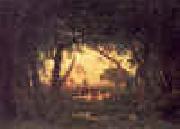 |
Theodore Rousseau
|
|
1812-1867
French
Theodore Rousseau Galleries
Rousseau's pictures are always grave in character, with an air of exquisite melancholy which is powerfully attractive to the lover of landscapes. They are well finished when they profess to be completed pictures, but Rousseau spent so long a time in working up his subjects that his absolutely completed works are comparatively few. He left many canvases with parts of the picture realized in. detail and with the remainder somewhat vague; and also a good number of sketches and water-color drawings. His pen work in monochrome on paper is rare; it is particularly searching in quality. There are a number of fine pictures by him in the Louvre, and the Wallace collection. contains one of his most important Barbizon pictures. There is also an example in the Ionides collection at the Victoria and Albert Museum. |
|
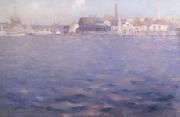 |
Theodore Roussel
|
|
English Painter, 1847-1926
English painter and etcher of French birth. He was born and educated in France and settled in England in 1878, when he quickly established a reputation. Largely self-taught, his few extant early paintings show an eclectic style that combines the techniques of the Old Masters, which he studied in detail, with the subject-matter of modern urban life. In 1885 he was introduced to James McNeill Whistler, his neighbour in Chelsea, London, and in consequence a lifelong friendship was formed. As Roussel was a member of Whistler's London circle his work in watercolour and oil was influenced by the latter in style and choice of subject-matter. His oft-quoted remark that he was a 'pupil of Whistler' is, however, belied by his frequently distinct style, as seen in such paintings as the Reading Girl (1886-7; London, Tate). In 1888 Whistler introduced him to the techniques of etching and drypoint, resulting in such etchings as the Sign of the 'White Horse', Parson's Green (c. 1893-4; see Rutter, pl. xxx). For the remainder of his life he relentlessly pursued the medium, even, like Whistler, designing his own special frames. Always fascinated by the theoretical and practical nature of colour science, he constantly experimented and was an early pioneer of the technique of colour etching in England, producing such works as Dawn. |
|
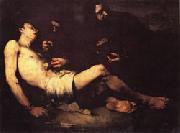 |
Theodule Ribot
|
|
Saint-Nicolas-d'Attez, 1823-Colombes 1891.
was a French realist painter. He was born in Saint-Nicolas-d'Attez, and studied at the École des Arts et Metiers de Chalons before moving to Paris in 1845. There he found work decorating gilded frames for a mirror manufacturer; he also studied in the studio of Auguste-Barth??l??my Glaize. After a trip to Algeria around 1848, he returned in 1851 to Paris, where he continued to make his living as an artisan. In the late 1850s, working at night by lamplight, he began to paint seriously, depicting everyday subjects in a realistic style. He made his Salon debut in 1861 with several paintings of kitchen subjects. Collectors purchased the works, and his paintings in the Salons of 1864 and 1865 were awarded medals. Ribot painted domestic genre works, still-lifes, portraits, and religious scenes. His preference was for painting directly from nature, emphasizing the contrasts of light and dark. His use of chiaroscuro to suggest psychological states grew from his admiration for Spanish and Dutch baroque masters such as Ribera and Rembrandt, an enthusiasm shared by his contemporaries Courbet and Bonvin. Members of Ribot's family are the likely models for many of his figure compositions, in which the subjects engage in humble activities, such as preparing meals or gathering in groups to read to each other. The light draws attention to faces and hands, which emerge sharply from dimly lit surroundings. Although the realism of Ribot's work aligns him with the most progressive artists of the generation preceding the Impressionists, he was no revolutionary, |
|
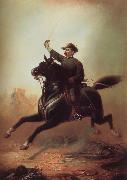 |
Thomas Buchanan Read
|
|
American Painter, 1822-1872,was an American poet and portrait painter born in Chester County, Pennsylvania. Read wrote a prose romance, The Pilgrims of the Great St. Bernard, and several books of poetry, including The New Pastoral, The House by the Sea, Sylvia, and A Summer Story. Some of the shorter pieces included in these, e.g., "Sheridan's Ride," "Drifting,""The Angler", "The Oath," and "The Closing Scene," have great merit. Read was briefly associated with the Pre-Raphaelite Brotherhood. His greatest artistic popularity took place in Florence. Among portraits he painted were Abraham Lincoln, Henry Longfellow, Alfred Tennyson, Elizabeth Barrett Browning, Robert Browning and William Henry Harrison. Read died from injuries sustained in a carriage accident, which weakened him and led him to contract pneumonia while on shipboard returning to America. |
|
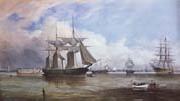 |
Thomas Robertson
|
|
January 9, 1829 ?C February 3, 1871,English dramatist and actor; brother of Madge Kendal. After spending several years as an actor, he turned to playwriting, initiating the ecup and saucere school of drama, which was characterized by its realism and its contemporary, domestic setting. His first successful play, David Garrick (1864), was followed by Society (1865) and Ours (1866). With Caste (1867) he began a close association with Squire Bancroft and his wife, Marie Wilton Bancroft, the actress, and they produced several of his plays. |
|
|
|
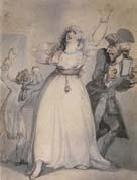 |
Thomas Rowlandson
|
|
English Illustrator, 1756-1827,English caricaturist, watercolourist, draughtsman and engraver. Although he is commonly thought of as a satirist, most of his drawings are gently humorous, and in some cases objective, records of urban and rustic life. With the exception of a small number of topographical drawings, they are characterized by an abundance of picaresque incidents, whether robust or sentimental, and have much in common with the novels of Laurence Sterne and Henry Fielding, which Rowlandson illustrated in 1808 and 1809. |
|
 |
Thomas Ruckle
|
|
was a house painter and sign painter in early nineteenth century Baltimore, Maryland, and an amateur painter. He is best known for his paintings The Battle of North Point, and The Defense of Baltimore. Ruckle was a veteran of the War of 1812, in which he had served as a corporal in the 5th Maryland Regiment of the Maryland Militia.
Ruckle was born in Ireland and, having moved to Baltimore, Maryland, he became a sign painter and house painter. It is likely that he had very little, if any, formal training as an artist. |
|
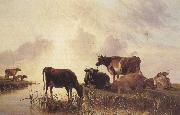 |
Thomas sidney cooper,R.A.
|
|
1803-1902
English painter. He was encouraged in his ambition to become an artist by Sir Thomas Lawrence and the animal painter Abraham Cooper (no relation; 1787-1868). He entered the Royal Academy Schools, London, in 1823. He subsequently taught art in Brussels where he met Eugene Verboeckhoven, whose work had a profound influence on him. Through Verboeckhoven he came to appreciate the work of such 17th-century Dutch painters as Aelbert Cuyp and Paulus Potter. In 1831 he returned to London, exhibiting at the Royal Society of British Artists. He exhibited 48 pictures at the British Institution between 1833 and 1863. The majority of his work was, however, exhibited at the Royal Academy; from 1833 to 1902 he exhibited 266 works there without a break, |
|
|
|
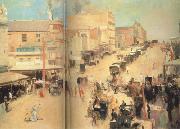 |
Tom roberts
|
|
British-born Australian Painter, 1856-1931
Australian painter of English birth. A leader of the HEIDELBERG SCHOOL and pioneer of plein-air Impressionism in Australia, he has been described as 'the father of Australian landscape painting'. Having moved to Melbourne in 1869, he studied at the East Collingwood and Carlton Schools of Design and the National Gallery of Victoria's School of Art (1874-81) while working as a photographic assistant. He led sketching expeditions with Frederick McCubbin and initiated student requests for reforms at the school. Returning to England, he enrolled in the Royal Academy Schools, London, on 6 December 1881, officially recommended by Edwin Long. In the summer of 1883 he toured Spain with the painter John Peter Russell. He learnt something of French Impressionism from Spanish art students Ramon Casas and Loreano Barrau (b 1864), and then followed the latter's advice to visit the Academie Julian in Paris. He returned to Melbourne in 1885 and the following year established the first summer camp at Box Hill with McCubbin and Louis Abrahams (1852-1903), portrayed in his painting the Artists' Camp (c. 1886; Melbourne, N.G. Victoria). According to the painter Arthur Streeton, it was Roberts's 'quick perception and expression of the principles of Impressionism in the year 1886, |
|
 |
Tommaso Ruiz
|
|
Active in Naples during the second half of the 18th Century
|
|
 |
Vaclav Vavrinec Reiner
|
|
(Czech: Vaclav Vavřinec Reiner; 8 August 1686 or 1689 - 9 October 1743) was a Baroque painter who lived and died in Prague, Bohemia. |
|
|
|
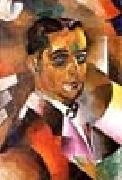 |
Vladimir Baranov-Rossine
|
|
(1888?C1944) was a Russian-Ukrainian painter, avant-garde artist (Cubo-Futurist), and inventor of Jewish ethnicity
Vladimir Baranov-Rossine was born in Kherson, Ukraine, to parents of Jewish ethnicity.
In 1902 he studied at the School of the Society for the Furthering of the Arts in St. Petersburg. From 1903 to 1907 he attended the Imperial Academy of Arts in St. Petersburg.
In 1908 he exhibited with the group Zveno ("The Link") in Kiev organized by the artist David Burliuk and his brother Wladimir Burliuk.
In 1910 he moved to Paris, wher until 1914 he was a resident in the artist's colony La Ruche together with Alexander Archipenko, Sonia Delaunay-Terk, Nathan Altman and others. He exhibited regularly in Paris after 1911.
He returned to Russia in 1914. In 1916 he had a solo exhibition in Oslo. In 1918 he had exhibits with the union of artists Mir Iskusstva ("World of Art") in Petrograd (St.Petersburg). In the same year he had an exhibition with the group Jewish Society for the Furthering of the Arts in Moscow, together with Nathan Altman, El Lissitzky and David Shterenberg. He participated at the First State Free Art Exhibition in Petrograd in 1919.
In 1922 Baranov-Rossine was the teacher at the Higher Artistic-Technical Workshops (VKhUTEMAS) in Moscow.
In 1924 he had the first presentation of his optophonic piano during a performance at the Bolshoi Theatre in Moscow - a synaesthetic instrument that was capable of creating sounds and coloured lights, patterns and textures simultaneously. |
|
|
|
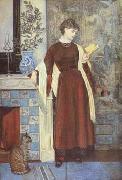 |
Walter Crane,RWS
|
|
1845-1915
English painter, illustrator, designer, writer and teacher. He showed artistic inclinations as a boy and was encouraged to draw by his father, the portrait painter and miniaturist Thomas Crane (1808-59). A series of illustrations to Tennyson's The Lady of Shalott (Cambridge, MA, Harvard U., Houghton Lib.) was shown first to Ruskin, who praised the use of colour, and then to the engraver William James Linton, to whom Crane was apprenticed in 1859. From 1859 to 1862 Crane learnt a technique of exact and economical draughtsmanship on woodblocks. His early illustrative works included vignette wood-engravings for John R. Capel Wise's The New Forest: Its History and its Scenery (1862). |
|
|
|
 |
Walter Richard Sickert
|
|
British Camden Town Group Painter, 1860-1942
British painter, printmaker, teacher and writer of German birth. Sickert was one of the most influential British artists of this century. He is often called a painter painter, appealing primarily to artists working in the figurative tradition; there are few British figurative painters of the 20th century whose development can be adequately discussed without reference to Sickert subject-matter or innovative techniques. He had a direct influence on the Camden Town Group and the Euston Road School, while his effect on Frank Auerbach, Howard Hodgkin and Francis Bacon was less tangible. Sickert active career as an artist lasted for nearly 60 years. His output was vast. He may be judged equally as the last of the Victorian painters and as a major precursor of significant international developments in later 20th-century art, especially in his photo-based paintings. |
|
|
|
 |
Willem Roelofs
|
|
Dutch Painter, 1822-1897
Dutch painter. He is said to have made his first sketches at the age of four; at fifteen he completed his first landscape painting. Many of these early works are in the print rooms of the Rijksmuseum, Amsterdam, and the Gemeentemuseum, The Hague. In c. 1837-8 he was apprenticed to the amateur painter Abraham Hendrik de Winter (1800-61) in Utrecht, where the Roelofs family had moved in 1826. In 1838 he entered his first paintings in the Exhibition of Living Masters in Amsterdam and Rotterdam. In the late summer of 1840 Roelofs became a pupil of the landscape and animal painter Hendrik van de Sande Bakhuyzen (1795-1860), with whom he made a study trip to Germany in 1841. Roelofs took a special interest in nature: he applied himself energetically both to painting and drawing, almost always selecting landscape subjects. He also studied entomology and accumulated a large collection of insects. After his training he returned to his parents in Utrecht. |
|
|
|
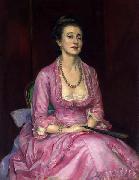 |
William Bruce Ellis Ranken
|
|
United Kingdom (1881- 1941 ) - Watercolours
painted Souvenir of the seventies. Signed with monogram and dated 1923 |
|
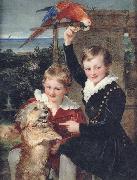 |
William Charles Ross
|
|
English Miniature Painter, 1794-1860
was a British painter. Early in his career, he was known for historical paintings, but he later gained fame for his miniatures and portraits. He was made a member of the Royal Academy in 1842. |
|
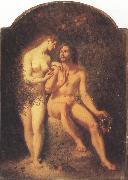 |
William Edward frost R.A.
|
|
1810-1877
was an English painter of the Victorian era. Virtually alone among English artists in the middle Victorian period, he devoted his practice to the portrayal of the female nude. Frost was educated in the schools of the Royal Academy, beginning in 1829; he established a reputation as a portrait painter before branching into historical and mythological subjects, including the sub-genre of fairy painting that was characteristic of Victorian art. In 1839 he won the Royal Academy's gold medal for his "Prometheus Bound," and in 1843 he won a prize in the Westminster Hall competition for his "Una Alarmed by Fauns" (a subject from Spenser's The Faerie Queen). He was elected an associate member of the Royal Academy in 1846, and a full member in 1870. Frost is widely recognized as a follower of William Etty, who preceded him as the primary British painter of nudes in the second quarter of the nineteenth century. |
|
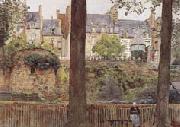 |
William Frederick Yeames,RA
|
|
1835-1918
English painter. The son of a British consul in Russia, Yeames was sent to school in Dresden after the death of his father in 1842. He also studied painting there. The collapse of the Yeames family fortune resulted in a move to London in 1848, where Yeames learnt anatomy and composition from George Scharf (1788-1860). He later took lessons from F. A. Westmacott. In 1852 he continued his artistic education in Florence under Enrico Pollastrini and Raphael Buonajuto, from whom he learnt the methods of the Old Masters. He drew from frescoes by Ghirlandaio, Gozzoli and Andrea del Sarto and painted in the Life School at the Grand Ducal Academy. He then went to Rome and made landscape studies and copied Old Masters, including Raphael's frescoes in the Vatican. His extensive study of Italian art gave him a precision and facility that assisted his artistic success upon his return to London in 1859. There he set up a studio in Park Place and became involved with the ST JOHN'S WOOD CLIQUE. He exhibited at the Royal Academy and the British Institution from 1859 and became an ARA in 1866. |
|
|
|
|
|
 |
William Ranney
|
|
(May 9, 1813 - November 18, 1857) was a 19th-century American painter, known for his depictions of Western life, sporting scenery, historical subjects and portraiture. In his 20-year career, he made 150 paintings and 80 drawings, and is considered the first major genre painter to work in New Jersey, and one of the most important pre-Civil War American painters.His work is on display in several museums across the United States. One of his contemporaries opined, "A specimen of Ranney is indispensable wherever a collection of American art exists." |
|
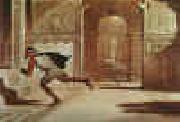 |
William Rimmer
|
|
1816-1879
William Rimmer Gallery
William Rimmer (20 February 1816?C20 August 1879) was an American artist born in Liverpool, England. He was the son of a French refugee, who emigrated to Nova Scotia, where he was joined by his wife and child in 1818, and who in 1826 moved to Boston, where he earned a living as a shoemaker. The son learned the father's trade; at fifteen became a draughtsman and sign-painter; then worked for a lithographer; opened a studio and painted some ecclesiastical pictures.
In 1840 Rimmer made a tour of New England painting portraits, he lived in Randolph, Massachusetts, in 1845-1855 as a shoemaker, for the last years of the decade practising medicine; practised in East Chelsea, Massachusetts and received a diploma from the Suffolk County Medical Society and in 1855 removed to East Milton, Massachusetts where he supplemented his income by carving busts from blocks of granite.
In 1860 Rimmer made his head of St. Stephen and in 1861 his Falling Gladiator. Rimmer's sculptures, except those mentioned and The Fighting Lions, A Dying Centaur, and a statue of Alexander Hamilton (made in 1865 for the city of Boston), were soon destroyed. He worked in clay, not modelling but building up and chiselling; almost always without models or preliminary sketches; and always under technical disadvantages and in great haste; but his sculpture is anatomically remarkable and has an early Greek simplicity and strength.
Rimmer published Elements of Design (1864) and Art Anatomy (1877), but his great work was in the classroom, where his lectures were illustrated with blackboard sketches.
Rimmer's most famous work, though not normally associated with him, is Evening: Fall of Day. This paint-on-canvas portrays Apollo, and a modified version was used by Swan Song Records, the recording label founded in 1974 by English rock group Led Zeppelin, in their label art. It is often mistaken to be a picture of Icarus, Lucifer, Satan, or Daedalus |
|
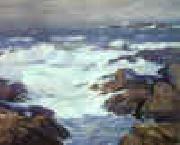 |
William Ritschel
|
|
1864-1949
William Frederic Ritschel (1864-1949) was an impressionist painter who was born in Nuremberg, Germany on July 11, 1864. As a youth, he worked as a sailor and began sketching seascapes. He studied art under Karl Raupp (1837-1918) and Wilhelm von Kaulbach (1805-1874) at the Royal Academy in Munich before immigrating to New York City in 1895. In 1911, he settled in Carmel-by-the-Sea, California and began painting Monterey Peninsula. He died in Carmel in 1949.
The Arizona State University Art Museum (Tempe, Arizona), the Art Institute of Chicago, the Crocker Art Museum (Monterey, California), the Davenport Museum of Art (Davenport, Iawa), Fisher Gallery (University of Southern California, Los Angeles), the Honolulu Academy of Arts, the Irvine Museum (Irvine, California), the Monterey Museum of Art (Monterey, California), the Museum of Art at Brigham Young University (Provo, Utah), the Newark Museum (Newark, New Jersey), the Oakland Museum of California (Oakland, California), the Pennsylvania Academy of the Fine Arts (Philadelphia), the Smithsonian American Art Museum (Washington, D. C.), Springville Museum of Art (Springville, Utah), and the University of Arizona Museum of Art (Tucson, Arizona) are among the public collections holding works by William Frederic Ritschel |
|
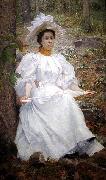 |
William Robinson Leigh
|
|
(September 23, 1866 - March 11, 1955) is a noted American artist, who specialized in Western scenes.
He was born at Maidstone Manor Farm, Berkeley County, West Virginia. He entered the Maryland Institute at age 14, then attended the Royal Academy in Munich. He returned to the United States and worked painting cycloramas and as a magazine illustrator. He married and fathered William Colston Leigh, Sr. (1901-1992).
In 1906, Leigh traveled to the American West and maintained a studio in New York City. In 1933, he wrote and illustrated The Western Pony. He also traveled to Africa and published a book Frontiers of Enchantment (1938). Hs adventures were chronicled in a number of popular magazines including Life, the Saturday Evening Post, and Colliers.He is known for painting the Grand Canyon and Yellowstone National Forest, but his primary interest were the Hopi and Navajo Indians
|
|
|
|
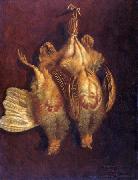 |
William Roos
|
|
William Roos (1808 - 4 July 1878) was a Welsh artist and engraver. Several of Roos' portraits, mainly of notable Welsh figures, are owned by the National Library of Wales.
|
|
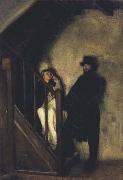 |
William Rothenstein
|
|
English Painter, 1872-1945
English painter, printmaker, teacher and writer. He was the son of a wool merchant and delighted in the grim landscape of his native Yorkshire, which was the subject of some early watercolours. At 16 he left Bradford to attend the Slade School of Art, London (1888-9), where he was a pupil of Alphonse Legros, and the Acad?mie Julian, Paris (1889-93). His talent was recognized as early as 1891, when an exhibition of his work and that of Charles Conder at the Galerie Hadrien Thomas in Paris attracted the attention of many artists including Pissarro and Degas. The latter invited Rothenstein to visit his studio and became a major influence on his development. After an inspiring four years he left Paris for Oxford |
|
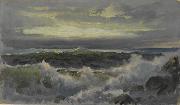 |
William Trost Richards
|
|
(June 3, 1833 - April 17, 1905) was an American landscape artist associated with both the Hudson River School and the American Pre-Raphaelite movement.
William Trost Richards was born on 3 June 1833 in Philadelphia. In 1846 and 1847 he attended the local Central High School. Between 1850 and 1855 he studied part-time with the German artist Paul Weber while working as designer and illustrator of ornamental metalwork. Richards first public showing was part of an exhibition in New Bedford, Massachusetts, organized by artist Albert Bierstadt in 1858. In 1862 he was elected honorary member of the National Academy of Design and Academician in 1871. In 1863, he became a member of the Association of the Advanced of Truth in Art, an American Pre-Raphaelite group. In 1866, he departed for Europe for one year. Upon his return and for the following six years he spent the summers on the East Coast. In the 1870s, he produced many acclaimed watercolor views of the White Mountains, several of which are now in the collection of the Metropolitan Museum of Art. Richards exhibited at the National Academy of Design from 1861 to 1899 and at the Brooklyn Art Association from 1863 to 1885. He was elected a full member of the National Academy in 1871.
Richards rejected the romanticized and stylized approach of other Hudson River painters and instead insisted on meticulous factual renderings. His views of the White Mountains are almost photographic in their realism. In later years, Richards painted almost exclusively marine watercolors.
His works are featured today in many important American museums, including the National Gallery, the Smithsonian American Art Museum, the Wadsworth Atheneum, the Philadelphia Museum of Art, the Yale University Art Gallery, the High Museum of Art, the Museum of Fine Arts, Boston, the Fogg Art Museum, the Brooklyn Museum of Art and the Thyssen-Bornemisza Museum.
|
|
|
|
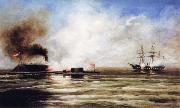 |
Xanthus Russell Smith
|
|
Marine, landscape, portrait, and historical painter.
American , 1839-1929
was an American artist best known for his illustrations of the American Civil War. Born in Philadelphia, Smith served in the United States Navy during the war and depicted naval battles with a variety of media, including pencil and oil paint. His best known work (right) recreates the 1864 battle between the CSS Alabama and USS Kearsarge off Cherbourg, France. Smith did not actually participate in most of the battles he illustrated; instead, he generally consulted those who were present at the engagements. |
|
|

